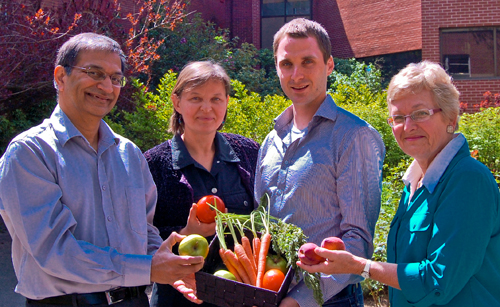Story by Samantha Beattie, a U of G student writer with SPARK (Students Promoting Awareness of Research Knowledge)

Hospitals and long-term care facilities want to incorporate local produce, meat and dairy into the health care system but just can’t figure out how to do it, says a regional research team that includes University of Guelph faculty.
Researchers say that the obstacles stopping hospitals and long-term care facilities from serving more local food are worth tackling, as local food can be the basis for fresher meals and potentially better patient care.
A key obstacle is the misconception held by health care personnel – shared by many Ontarians – that local food consists primarily of fruits and vegetables. It’s not. Meat, dairy, eggs and grain products are also produced in Ontario. However, since local food is primarily thought of as produce, people often believe that there is a seasonality and supply problem associated with all local food. In reality, that’s not the case, with Ontario products available year-round.
Profs. Paulette Padanyi and Vinay Kanetkar, Marketing and Consumer Studies, along with Linda Varangu and Brendan Wylie-Toal from the Canadian Coalition for Green Health Care and My Sustainable Canada, and Prof. Alison Blay-Palmer from Wilfrid Laurier University, conducted three studies to determine what needs to be done to make local food more prevalent in hospitals and long-term care facilities.
Specifically, they wanted to know what it would take to increase local food usage by 20 per cent across Ontario’s health care system by 2015.
“That increase would create an institutional market for local foods,” says Padanyi.
Currently, tight budgets paired with concerns about food safety regulations and limited availability prevent hospital food service managers from buying more from local farmers and producers. Instead, they tend to stick with conventional big food suppliers that offer larger, cheaper and more consistent quantities.
Padanyi says there’s an opportunity for the province to promote the fact that current storage and production technologies allow local produce, meat and dairy to be available in large quantities throughout the year. She adds that Foodland Ontario – one of the most identifiable brands in the province – should expand its existing initiatives to publicize and educate people about these developments.
The team also recommends that the province dedicate more funding for food purchases. Researchers found that food budgets range from $30 to $35 per patient per day, but after factoring in staff wages and food preparation, only $7 to $8 is available for purchasing food. As a result, food service managers tend to end up sacrificing quality for quantity.
The next step in the project is a report providing case studies of the efforts undertaken by some health care facilities in Ontario to increase their use of local food.
The project is being funded by the University of Guelph-OMAFRA Partnership Fund with supplementary support from the Canadian Coalition for Green Health Care.